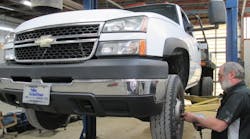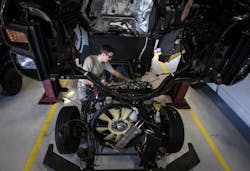If you’re in the business of selling vehicle parts, then you may be about to witness a healthy uptick in sales volumes for a stretch – this despite record sales of new vehicles over the last few years, especially where cars, sport utility vehicles (SUVs) and pickup trucks are concerned.
That’s because older models – especially ones around five years in age and ones 12 years or older – are staying on the road longer and accruing more mileage.
That means (tah dah!) they’ll need more parts and services, at least according to the data analyzed by research firm IHS Markit.
During the annual Automotive Aftermarket Products Expo (AAPEX) held last week in Las Vegas, Mark Seng, director, global automotive aftermarket practice at IHS Markit, noted that while new vehicle sales are expected to reach nearly 90 million units globally this year, the number of global vehicles in operation is expected to exceed nearly 1.4 billion vehicles by 2021, with two billion vehicles in operation expected by 2040.
[In the U.S., new vehicle sales are expected to reach 17.4 million units this year, a slight decline from last year, before rising to 17.5 million units in 2017, he added.]
That means – despite the record pace of new vehicle sales – the population of older vehicles will keep growing.
The aftermarket definitely felt the 40% drop in new light vehicle registrations experienced during the downturn of 2008-10, Seng noted.
However, the impact of that on the vehicles in operation indicates the volumes of vehicles in the new to five years old category will grow 16% by 2021, and while vehicles in the six to 11 year-old range will grow just 5%, the population of vehicles that are aged 12 years or older will grow 10%, according to IHS Markit projections.
Indeed, it is the number of older vehicles on the road that are growing the fastest – with vehicles 16 years and older expected to grow 30% from 60 million units today to 81 million units by 2021.
IHS Markit research also indicates 20 million vehicles on the road in 2021 will be more than 25 years old.
“Some believe that high new-vehicle sales are not a good thing for the aftermarket,” Seng noted during a presentation at AAPEX. “However, I don’t see it that way. Anytime you are adding vehicles to the fleet that’s a good thing. It’s our ‘new business pipeline’ if you will. [It means] simply more vehicles to repair down the road.”
Vehicle miles traveled in the U.S. continues to increase, too, driven partly by a continued spate of low fuel prices – adding to the “aging” process for vehicles.
For the past two years, consumers have traveled more than 3 trillion miles per year, which is up from seven years of declining or flat miles traveled between 2006 and 2013, according to the Department of Transportation and Federal Highway Administration (FHWA) numbers.
From a global perspective, light duty vehicle miles traveled are estimated to reach more than 10 trillion miles this year, according to IHS Markit.
“The aftermarket must be prepared to address the needs of the aging vehicle population,” Seng said. “More repair opportunities will abound for these older vehicles, including from consumers who may be a vehicle’s third or fourth owner.”
But what kinds of light vehicles are we talking about here? IHS Markit’s data offers some further insight:
- The firm tracks nearly 30 different vehicle segments but just four represented nearly 60% of new vehicle registrations in 2015.
- Compact CUVs or “crossovers” are commanding nearly 19% of the market year-to-date in 2016, with traditional compact cars (13.4%), mid-size sedans (12.7%) and full-size pickup trucks (12.3%) rounding out the top four.
- In the U.S., import brands are outpacing the traditional domestic brands, which allows for growth among import parts providers and service experts, according to IHS Markit.
- Market share of new vehicle sales held by traditional domestic brands in the U.S. is declining – accounting for just 46% in 2015.
- IHS Markit forecasts suggest import nameplates will account for 57% of U.S. light vehicle market share by 2021.
- As a percentage of vehicles in operation, cars with import nameplates increased by more than 50% since 2002, and likewise, import branded light trucks have nearly tripled in number over the same 14 year timeframe.
One final though thought here as we talk about replacement part demand in the light vehicle space: don’t forget that much of this is computer related, meaning repairs will be vastly more complex than in times past.
For example, IHS Markit noted that new premium vehicles today rely on more than 100 million lines and over 50 onboard computers to function.
“This level of technical sophistication is virtually unmatched by other industries,” Seng emphasized.
“This technological complexity is the foundation for the coming autonomous and connected car,” he added. “And even though these vehicles will not dominate the market for another couple of decades, the technology found on those future vehicles are entering repair bays more and more.”
That’s going to put further stress on the need to find skilled technicians – savvy in both computer learning and mechanical repair skills – to keep today’s vehicles up and running on the road. That particular challenge isn’t going away anytime soon.




